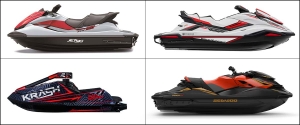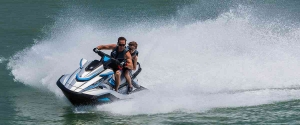![Are Yamaha WaveRunners Reliable and Good? [Video]](https://www.jetdrift.com/wp-content/uploads/2020/07/yamaha-waverunner-faqs.jpg)
Are Yamaha WaveRunners Reliable and Good? [Video]
Are Yamaha WaveRunners Reliable and Good? – we frequently get this question, and the answer is yes! Yamaha WaveRunners have a reputation for industry-leading reliability and durability. If you have doubts, visit a jet ski rental shop, where you will more than likely find Yamaha PWCs. And rental shops stick with these machines for good reason!
If you want to learn more about these amazing machines and their reliability, this post is for you.
We at JetDrift have compiled all you need to know under one roof!
Are Yamaha WaveRunners Reliable and Good?
How Reliable are Yamaha Jet Skis?
There’s no question that Yamaha WaveRunners are the most reliable jet skis in the marketplace. It’s common knowledge that Japanese vehicles and vessels are among the most reliable machines, and Yamaha WaveRunners are no exception.
In a nutshell, the main reasons why Yamaha WaveRunners are so reliable are as follows:
- WaveRunners feature the largest engines in each PWC category.
- They come with lower compression and less cc/HP ratios than competitor models.
- These engines are simpler, easier to work on, and not so picky about engine oil.
- WaveRunners feature simpler parts and systems than competitor models (open-loop cooling, coupler, maintenance-free supercharger, etc.)
| Brand | Engine Type | cc | HP | HP/cc | Cylinders | Super- charged |
|---|---|---|---|---|---|---|
| Yamaha | TR-1 | 1049 | 100/ 110/ 125 | 10.5/9.5/8.4 | 3 | No |
| Yamaha | Yamaha Marine HO | 1812 | 180 | 10.1 | 4 | No |
| Yamaha | Yamaha Marine SVHO | 1812 | 250 | 7.2 | 4 | Yes |
| Sea-Doo | Rotax 900 ACE | 899 | 60 | 15.0 | 3 | No |
| Sea-Doo | Rotax 900 ACE HO | 899 | 90 | 10.0 | 3 | No |
| Sea-Doo | Rotax 1630 ACE | 1630 | 130/170 | 12.5/9.6 | 3 | No |
| Sea-Doo | Rotax 1630 ACE | 1630 | 230/300 | 7.1/5.4 | 3 | Yes |
| Kawasaki | Kawasaki 1498 | 1498 | 160 | 9.4 | 4 | No |
| Kawasaki | Kawasaki 1498 | 1498 | 310 | 4.8 | 4 | Yes |
Are WaveRunners High Maintenance?
Although jet skis are considered high-maintenance machines, Yamaha WaveRunners require less attention and care than competitor models. They come with simpler engines and features, which are less likely to fail and easier to work on.
For instance, the supercharger on many Sea-Doo models requires periodic inspections and rebuilding. What’s more, these superchargers protrude into the engine, so a supercharger failure can easily deliver metal debris into the engine oil.
Regarding Kawasaki jet skis, the supercharger on these machines is driven by a belt, which adds unnecessary complexity to the system.
In contrast, WaveRunner superchargers are virtually maintenance-free and last longer.
Another key difference between a Sea-Doo and WaveRunner is their cooling system, as the latter features a much simpler open-loop engine cooling.We need to mention the fastidious carbon ring on a Sea-Doo, a part that you have to keep your eyes on all the time as carbon ring wear is the leading reason why so many Sea-Doos sink.
If you have a Kawasaki or a WaveRunner, you don’t have to be afraid of these issues as they utilize a coupler instead of a carbon ring seal. These machines feature two-piece driveshafts that are connected with a coupler in the engine bay.
One of these shafts connects the engine and the coupler while the second connects the coupler and the impeller.
What is the Most Reliable Yamaha WaveRunner?
The most reliable WaveRunners are arguably the naturally-aspirated Recreation and Rec-Line models, namely the EX and the VX family.
FAQs About Yamaha WaveRunners
What Brand is WaveRunner?
The WaveRunner brand is manufactured by Yamaha. The Japanese manufacturer is a well-known name in the powersport market as, besides jet skis, it produces motorcycles, dirt bikes, ATVs, UTVs, boats, and outboard engines.
When did Yamaha Start Making the WaveRunner?
Yamaha entered the PWC market in 1986 by revealing the first WaveRunner, the WR 500. The weird-looking and less popular WaveJammer also made its debut that year.
What is the Most Powerful Yamaha WaveRunner?
The most powerful Yamaha WaveRunners are the supercharged “SVHO” models.
These skis feature a 1,812cc 4-cylinder, 4-stroke Yamaha marine engine. Thanks to its supercharger and intercooler, this power source cranks out 250 HP.
Which WaveRunners are Supercharged?
The supercharged Yamaha WaveRunner models are the GP1800R SVHO and the FX SVHO family (including the FX, FX Limited, FX Cruiser).
Are WaveRunners Carbureted?
As a rule of thumb, each modern 4-stroke Yamaha WaveRunner utilizes a fuel injection system. In contrast, most 2-stroke WaveRunners are carbureted as EFI models appeared after the Millennium in Yamaha’s fleet.
One of the first fuel-injected 2-stroke WaveRunner was the 2003 GP1300R.
When Did Yamaha Start Making 4-Stroke WaveRunners?
The first 4-stroke WaveRunner was the 2002 Yamaha FX140.
To meet the 2006 EPA emission standards, Yamaha decided to upgrade the power source of their WaveRunners. The outdated 2-stroke Yamaha PWCs were discontinued in the late 2000s to make room for their cleaner 4-stroke successors.
Where is the Serial Number on a Yamaha WaveRunner?
When it comes to identifying a WaveRunner, it’s good to know that these machines feature three different identification numbers, including:
- Hull Identification Number (HIN) – It’s stamped on a metal plate mounted on the swim platform.
- Primary identification number (PRI-ID): You can find this number on a plate inside the engine compartment.
- Engine Serial Number: It’s stamped on a plate attached to the engine.
What are Yamaha WaveRunners Made of?
The Yamaha WaveRunners made of fiberglass or NanoXcel depending on the model. Entry-level models come with a complete fiberglass body, while other models feature a NanoXcel top deck combined with a fiberglass hull.
Yamaha has been manufacturing NanoXcel hulls for many years, but for 2022 models, the company switched back to the proven fiberglass.
Are Yamaha WaveRunners Painted or Gelcoated?
As a rule of thumb, older WaveRunners with fiberglass bodies were typically covered with Gelcoat while the newer NanoXcel shells are painted.
When did WaveRunners Go 4-stroke?
Yamaha WaveRunners went 4-stroke in 2002. In May 2002, the company introduced the FX-140 WaveRunner, powered by a low-emission 4-stroke engine. From 2009 on, all sit-down type Yamaha WaveRunners have been manufactured with 4-stroke power sources. Surprisingly, the legendary SuperJet still features a 2-stroke, 2-cylinder engine.
Where are Yamaha WaveRunners Made?
Yamaha WaveRunners are made in Newnan Georgia. The Yamaha Motor Manufacturing Corporation of America (YMMC) facility employs around 1,500 people and covers an area of 280 acres. It’s not just the hull and other main parts, but the engines are also manufactured and assembled in the US!
When did Yamaha Introduce RiDE?
Yamaha introduced RiDE in 2015. RiDE is the acronym for Reverse with Intuitive Deceleration Electronics, but simply put it’s the brake and reverse system on WaveRunners. You can discover and compare PWC brake systems here.
What is a Superjet?
The Superjet is the only stand-up WaveRunner in Yamaha’s fleet. It was introduced in 1990 and to the delight of many fans, it’s still available on the market. Thanks to its small hull and lightweight 2-stroke engine, the Superjet offers an amazing power-to-weight ratio.
Who is WaveRunner Papa?
Neil Kobayashi is known as “WaveRunner Papa”. This is because he was the development manager when Yamaha developed and introduced its first WaveRunner models.
What does WaveRunner Mean?
WaveRunner is the brand name of Yamaha’s personal watercraft. You can easily recognize WaveRunners on the water because they shoot water out their rear. Just like Yamaha, every competitor PWC manufacturer has their own name for their PWCs. These are as follows:
| Started | Ended | Brand name | Manufacturer |
|---|---|---|---|
| 1968 | - | Sea-Doo | Bombardier (BRP) |
| 1972 | - | Jet Ski | Kawasaki |
| 1978 | 1992 | WetBike | Arctic Cat |
| 1985 | 1993 | Wet Jet | Koronis Part Inc. (Sold to MasterCraft) |
| 1986 | - | WaveRunner | Yamaha |
| 1992 | 2004 | SeaLion | Polaris |
| 1993 | 1999 | Tigershark | Arctic Cat |
| 1994 | 1997 | Wet Jet | MasterCraft |
| 2002 | 2009 | AquaTrax | Honda |
| 2004 | 2006 | Hydrospace | Hydrospace (sold to Benelli) |
| 2006 | - | Burrasca | Belassi |
| 2008 | - | Krash | Krash Industries |
| 2018 | - | Narke Electrojet | Narke |
| 2018 | - | Orca | Taiga |
How do You Use a Yamaha WaveRunner?
How do you use a Yamaha WaveRunner?
You can use a Yamaha WaveRunner in the same way as any other PWC. You can steer it with the handlebar, while accelerating with the throttle lever. If you are a beginner, don’t miss our step-by-step guide on how to ride a PWC!
How do you break-in a WaveRunner?
According to Yamaha, to break-in a WaveRunner you have to make sure first that the oil level is correct in the engine. As the next step, launch the WaveRunner and for the first 5 minutes operate at 2000 RPMs. Then, for the next 1.5 hours, you have to keep the RPMs below 5000. After this short brake-in period, you can use the WaveRunner without any further restrictions.
Do WaveRunners have keys?
No, Yamaha WaveRunners don’t have keys. Instead, they have a special security system. You can lock/unlock this with a remote-control transmitter. While you ride your WaveRunner, you have to keep this transmitter at all times in the watertight storage compartment.
But don’t forget, just like any other PWC, WaveRunners also feature shut-off switches for safety reasons. This means you have to attach a clip to this shut-off switch so that you can start the engine. You also have to secure this clip to your life jacket or wrist with the shut-off lanyard. If you fall off the WaveRunner, this clip will shut the engine down.
Why do Yamaha WaveRunners shoot water?
Yamaha WaveRunners shoot water for better visibility. The water spray does the same job as dune flags on ATVs and buggies. You can find a hole on the swim platform from which the water squirts when the engine is on. Contrary to popular belief this water doesn’t come from the cooling system, but directly from the pump. This shooting water on a WaveRunner can be annoying if you want to install a fishing rack on the swim platform. That’s why PWC anglers cancel this feature.
Purchasing a WaveRunner
How much is a brand new Yamaha WaveRunner?
New Yamaha WaveRunners cost around $7,000 – $18,000 depending on the model.
What are the most popular WaveRunners on the market?
The most popular WaveRunners are arguably the VX series. The durability and reliability of these WaveRunners are legendary, which is why you can find these PWCs in many rental shops. These recreation WaveRunners are great for families and the average rider. When it comes to performance models, the Yamaha GP1800R is one of the best choices of racers and performance-minded buyers.
Do Yamaha WaveRunners come with trailers?
No, unfortunately, Yamaha WaveRunners don’t come with trailers. This means if you want to trailer it around, you will have to purchase a trailer separately. Your other option is to store your WaveRunner in a marina or a drive-on PWC dock.
Does Yamaha still make jet boats?
Yes, besides WaveRunners and outboard motors, Yamaha still makes jet boats. In the past Sea-Doo also manufactured jet boats, but left this market in 2012.
Conclusion – Are WaveRunners Worth the Money?
Yes, there’s no question that Yamaha WaveRunners are worth every penny. These amazing machines come with reliable engines and many advanced features that you need on the water. WaveRunners are very reliable and durable products; this is why most PWC rental services choose this brand over the competitors!And finally, don’t forget that every Yamaha WaveRunner is manufactured in the US!
If you are considering buying a new WaveRunner, you can discover the latest models here.


![WaveRunner Horsepower Chart [All 2024 Models] Yamaha WaveRunner Horsepower Chart](https://www.jetdrift.com/wp-content/uploads/2019/12/yamaha-waverunner-horsepower-chart-300x125.jpg)
